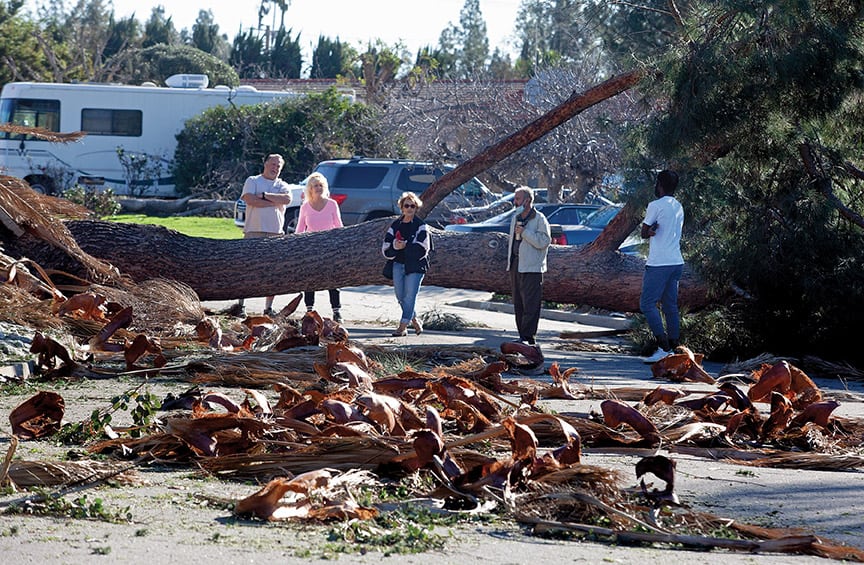2022 windstorm: taking stock, one year later

by Char Miller | special to the Courier
The signs that a powerful windstorm ravaged Claremont during the evening of January 21, 2022 are almost invisible, but they’re there: a canted stump on 12th Street; a new sidewalk on Claremont Boulevard; macadam patches along Foothill Boulevard mark where toppled trees had punctured its surface.
That said, it’s hard to forget what I encountered the next morning when I lit out for my daily ramble. That walk through the darkened town became a trek. With my way west blocked by three towering pines that had collapsed, taking streetlights and power lines with them, I pivoted east and ran into even greater destruction. Eighth Street was impassable: the largest of its downed trees was a massive pine (planted in 1952) that had crashed across the street and into a house. The next morning, I watched fleet-footed runners turn the clogged road into a steeplechase course, leaping over branches and trunks.
East of Indian Hill the damage intensified. The 300 block of west Seventh Street took a beating. Many of its north side trees had collapsed, buckling sidewalks and snapping irrigation lines. One of them crushed a house and a car; the rusting wreck remains, a forceful reminder of that night’s blunt-force trauma.
More stunning still was what happened to Pomona College’s Marston Quad, where generations of graduating seniors have processed beneath Stover Memorial Walk’s majestic alley of oaks. A microburst knocked down eight; they fell into the beds at their feet, limbs locked in a lover’s embrace. Cedars and pines were upended, as was a century-old eucalyptus that obstructed College Avenue. The college’s communal core had been torn asunder.

Residents of Butler Court in north Claremont inspect the large pine that fell across their street during last year’s wind storm, effectively marooning about a dozen homes. Neighbors pooled their efforts to clear a section of the tree so those who were stranded could get out. Courier photo/Steven Felschundneff
This uprooting, arboreal and emotional, reverberates still. It will take decades for the new live oaks to replicate what the windstorm splintered. The Pomona class of 2062 might be the first to stroll beneath Stover’s fully fledged canopy, something that a half-century earlier the class of 2012 would have taken for granted.
Yet just as a windfall in a forest clears the way for its understory to grow, last year’s tempest has opened the possibility of new narratives — not about loss but gain. Here are three:
Recycle: once the howling winds abated, my colleague artist Michael O’Malley spray painted his initials on many of Marston Quad’s largest trunks that arborists later cut up and hauled behind the studio arts building. There they rest, looking like elephant seals that lumber up on California’s central coast beaches. In time these logs’ wood fiber will kindle the creative imagination of faculty and student artists.

Jaeger Park suffered major damage as numerous large trees were toppled by winds. Courier photo/Peter Weinberger
Reuse: the remaining debris was turned to good use. For days, the high-pitched whine of chippers echoed across campus, with crews then spreading the mulch around vegetation or over newly dug out grass medians to help make a more drought-resistant landscape. A pattern replicated citywide; residents quickly whittled down four-foot high mulch mounds in the Metrolink parking lot.
Reclaim: for their capstone project, a team of environmental analysis seniors focused on Marston Quad’s future. If the iconic site was to be rehabilitated, on what grounds? A question that was literal (would the college simply replant non-native trees and plants?) and political (who would decide and on what basis?). To facilitate greater public input about the quad, the students mapped and catalogued what trees fell where, conducted an alumni survey (which generated more than 300 responses), and held two forums. One respondent spoke for many when they argued that the quad shouldn’t remain “a water sink in a water-scarce climate.”
The students concurred and urged the college to plant more native biota to reduce irrigation and increase biodiversity. But this restoration must be paired, they wrote, with a deeper connection with the Tongvan people, who had stewarded this semi-arid terrain for millennia. As a small gesture of reconciliation and reparation, the team helped shovel a desert willow into the quad’s southwestern corner. It’s thriving.
Char Miller teaches environmental history at Pomona College and is author of “Natural Consequences: Intimate Essays for a Planet in Peril.”









0 Comments